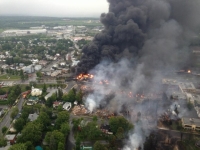On July 3, the Association of American Railroads (AAR) released June 2014 data showing oil-by-rail and petroleum products at-large are moving at record levels throughout North America.
The release of the data comes on the heels of the ongoing oil-by-rail nationwide week of action launched by environmental groups.
For the 26th week of 2014 (the half year point) in the U.S., 18.5% more tank cars were on the tracks carrying petroleum and/or petroleum products than last year, a total of 15,894 cars.
Examined on a year-to-date basis, 7.0% more of those same tank cars were on the tracks in the U.S. this year than last, totaling 380,961 cars to date.

Table Credit: Association of American Railroads
Across the border in Canada, the same trend lines exist: for the 26th week of 2014, 6.9% more cars moved petroleum and/or petroleum products by rail than in the 26th week of 2013.
Looked at in terms of year-to-date compared to 2013, that totals a 7.7% increase in tank cars moving the commodity by rail.

Table Credit: Association of American Railroads
“Bomb trains,” as some critics call them, move oil obtained from hydraulic fracturing (“fracking”) in North Dakota's Bakken Shale basin to terminals, holding facilities and markets both in the U.S. and Canada.
Hence the upsurge in unit cars carrying petroleum and/or petroleum products both north and south of the border.
Looked at through the lens of North America, 14.6% more tank cars carried petroleum and/or petroleum products during the 26th week of 2014 compared to the same time in 2013.
And 7.0% more of those tank cars have moved petroleum and/or petroleum products to market so far this year as compared to last year.

Table Credit: Association of American Railroads































